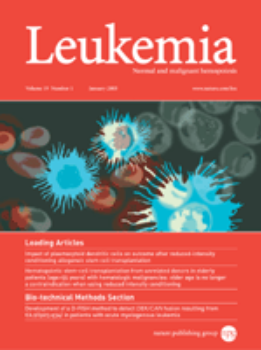Clonal evolution and apoptosis resistance in myelodysplastic neoplasms and acute myeloid leukemia under treatment: insights from integrative longitudinal profiling.
IF 13.4
1区 医学
Q1 HEMATOLOGY
引用次数: 0
Abstract
Treatment of high-risk Myelodysplastic Neoplasms (hr-MDS) and (secondary) Acute Myeloid Leukemia (AML) remains a clinical challenge. The combination of azacitidine and venetoclax (aza/ven) may improve treatment outcomes, but still fails in a significant fraction of patients. We established a single-center collection of longitudinal samples from patients with MDS and AML/sAML and performed comprehensive genetic, proteomic and functional apoptosis profiling to identify biomarkers and targetable escape mechanisms to aza/ven. Baseline genetic characterization (n = 55) identified high-risk genetic alterations, while longitudinal analyses (n = 268, mean 8.7 [3-20] timepoints) revealed distinct genetic profiles of clonal evolution. Functional BH3-profiling at treatment initiation identified heterogeneous dependencies on BCL-2 family members. Notably, high BCL-2 dependence correlated with genetic response to aza/ven and improved overall survival, whereas increased BCL-xL dependence was associated with resistance. We further identified patterns of acquired resistance, with loss of apoptotic priming and shifts in anti-apoptotic dependencies contributing to treatment failure. BH3 profiling revealed functional shifts toward MCL-1 and/or BCL-xL in individual cases, suggesting potential therapeutic targets to overcome resistance. In vitro, BCL-xL inhibition effectively counteracted resistance in increased BCL-xL dependence cases. In summary, we characterized treatment-associated clonal evolution in MDS and AML, providing insights into clinical response, disease progression and potential individualized therapeutic strategies.骨髓增生异常肿瘤和急性髓系白血病在治疗中的克隆进化和细胞凋亡抵抗:来自综合纵向分析的见解。
高危骨髓增生异常肿瘤(hr-MDS)和(继发性)急性髓系白血病(AML)的治疗仍然是一个临床挑战。阿扎胞苷联合venetoclax (aza/ven)可能改善治疗结果,但仍有相当一部分患者失败。我们建立了MDS和AML/sAML患者的单中心纵向样本收集,并进行了全面的遗传、蛋白质组学和功能性凋亡分析,以确定生物标志物和aza/ even的靶向逃逸机制。基线遗传特征(n = 55)确定了高风险遗传改变,而纵向分析(n = 268,平均8.7[3-20]个时间点)揭示了克隆进化的不同遗传谱。治疗开始时的bh3功能分析确定了对BCL-2家族成员的异质性依赖。值得注意的是,高BCL-2依赖性与aza/ even的遗传应答和总生存率的提高相关,而BCL-xL依赖性的增加与耐药性相关。我们进一步确定了获得性耐药的模式,凋亡启动的丧失和抗凋亡依赖性的转变导致了治疗失败。BH3分析揭示了个体病例中MCL-1和/或BCL-xL的功能转变,提示了克服耐药性的潜在治疗靶点。在体外,BCL-xL抑制有效地抵消了BCL-xL依赖性增加病例的耐药性。总之,我们描述了MDS和AML的治疗相关克隆进化,为临床反应、疾病进展和潜在的个体化治疗策略提供了见解。
本文章由计算机程序翻译,如有差异,请以英文原文为准。
求助全文
约1分钟内获得全文
求助全文
来源期刊

Leukemia
医学-血液学
CiteScore
18.10
自引率
3.50%
发文量
270
审稿时长
3-6 weeks
期刊介绍:
Title: Leukemia
Journal Overview:
Publishes high-quality, peer-reviewed research
Covers all aspects of research and treatment of leukemia and allied diseases
Includes studies of normal hemopoiesis due to comparative relevance
Topics of Interest:
Oncogenes
Growth factors
Stem cells
Leukemia genomics
Cell cycle
Signal transduction
Molecular targets for therapy
And more
Content Types:
Original research articles
Reviews
Letters
Correspondence
Comments elaborating on significant advances and covering topical issues
 求助内容:
求助内容: 应助结果提醒方式:
应助结果提醒方式:


